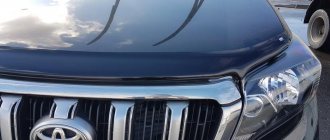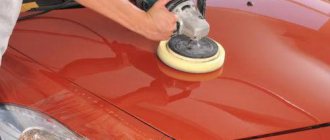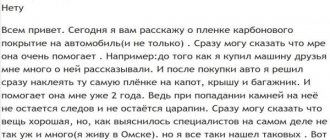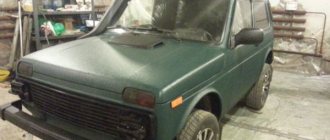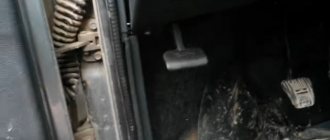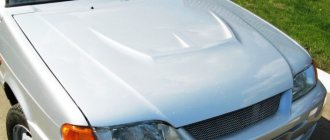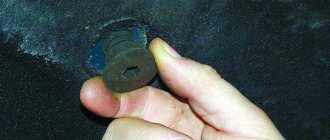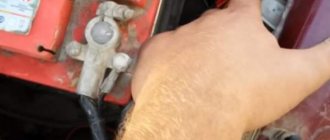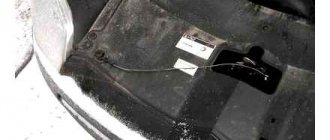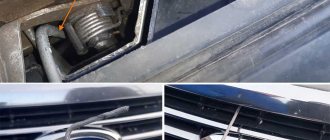Comments: no Published: 12/01/2015
Rating:
Tags: Vinyl film Protective film Carbon film
Even if you properly monitor the condition of your car, after a while the appearance of your car deteriorates slightly due to chips, scratches and dents on the hood. The cause of such damage is the impact of stones flying out from under the wheels of a car moving in front of you. Even minor damage to the coating can lead to serious consequences: corrosion develops very quickly and can cause a lot of harm.
Pros and cons of film on the hood
Automotive experts consider the hood to be one of the most vulnerable parts of the car, because all the stones on the road, dirt, bird droppings and other mechanical damage occur in this place. The hood is also susceptible to fading from the sun, which can cause the car’s factory paint to become lighter. Even small chips and scratches that appear on the hood can cause rust to form over time, which will affect the technical condition of the car.
The film on the hood is more important when buying a new car. Although those car enthusiasts who have owned a vehicle for a long time do not underestimate the importance of using such means of protecting the car specifically for the hood.
Among the positive characteristics of the hood adhesive technology, the following qualities of the film can be highlighted:
- a high-quality film may not peel off the paintwork for a long period;
- after gluing, the film does not require additional polishing or maintenance;
- performs a protective function against rust and corrosion and preserves the properties of paintwork;
- is a strong coating against chemical and mechanical intervention;
- when it rains or when cleaning the car, water does not enter under the cavities of the film;
- resistant to fading and fading;
- has thermal resistance to temperature changes;
- if necessary, can be easily dismantled;
- has a low cost;
- the gluing procedure does not take much time;
- in some cases it replaces car painting.
Disadvantages of the film pasting procedure:
- Vinyl material is not always resistant to yellowing or fading. Sometimes this requires re-gluing a certain area.
- Polyurethane film is 5 times more expensive than plain vinyl film.
How can they be removed?
Removing damage from the surface of a car body requires the use of special tools. Today, automobile stores offer a wide range of similar compounds, differing in composition and price. To choose the right product, you need to know what they are all intended for and which one is best suited for a particular car.
Selection and comparison of funds
Abrasive polishes are used to remove small stains and scratches from the body surface. They contain special substances that have cleansing properties - marble powder, clay and other components. It is thanks to them that a polished car acquires a noble appearance and a mirror-like shine.
A type of polish designed to remove minor damage from the body
After polishing, experts advise covering the surface of the body with varnish - it protects the coating, maintains shine and protects against corrosion for a long time.
Another type of damage repair product is wax. They are used most often due to their affordability. Despite the fact that they give the car an attractive appearance, they can only be used to eliminate minor scratches and imperfections in the paintwork, nothing more. Another disadvantage is that they are washed off the first time you wash the car. The most expensive and high-quality wax polishes stay on the surface of the body for a maximum of two to three visits to the car wash.
Wax compounds are one of the types of means for eliminating body defects
The third type of compounds for removing chips and scratches is synthetic compounds. They differ in their composition, and are therefore divided into three categories:
- Cleaners. They contain synthetic components that remove old paint layers and minor scratches. The result of treatment with such compounds is noticeable immediately. Cleaners are divided into two types, one of which is used for metallic paints, and the second for all other types of paints. After treatment with such compounds, the surface of the body is covered with varnish or other protective composition, which will preserve the shine of the body for two to three weeks.
A protective agent that removes traces of minor scratches, dirt and tar from the hood of a car. - Polymer compositions. Remove deep damage from plastic parts. Perhaps the most common type of product due to its advantages and properties: all defects are removed from the plastic and the body is protected at the same time. The second advantage is the durability of the coating: the shine of the body remains for two months even if the car is washed frequently. However, such polishing also has weaknesses: the process is too long and the cost of the product is high.
Designed to remove damage from plastic parts - Silicone polishes. Similar to wax products, the additional advantage is that they are low price and easy to apply to the surface of the body. The downside is the fragility of the coating.
Removing minor scratches
Surface polishing
- Before carrying out work, the car body is thoroughly washed and wiped dry. The location of all defects and problem areas - scratches, dents and chips - is noted.
A mandatory step before polishing the body is washing - Rust and dirt are removed from damaged areas. The polish is applied in a thin layer with a soft, clean sponge in a circular motion. The layer dries completely in 10–20 minutes.
Manually or automatically apply a layer of polish to the body in a circular motion - The surface treated with the composition is polished with suede or soft cloth until shiny. The remaining scratches are removed in the same way.
Rub the polish with a soft cloth until it becomes shiny. - You can remove polish from car body parts using a regular cleaner.
Video: polishing a car hood
Using wax or pencil
Minor and shallow scratches of the paintwork material are eliminated by treating with wax or pencil. Damaged areas are pre-cleaned and degreased - for this you can use gasoline or white spirit.
A pencil that can be used to remove scratches from the surface of the body
Pencil or wax is applied to the damage in several layers and then dried. The disadvantage of such products is their short service life: periodically they need to be renewed in defective areas or a layer of paint must be applied over them.
Primer and surface painting
Deep and serious chips can only be removed by priming and painting the body. Damaged areas are prepared in a similar way - cleaned and degreased.
- A layer of primer is applied over the cleaned chips. The composition used may vary depending on the nature of the damage. The layer of primer applied must be very, very thin; The product is applied with a rubber spatula and dried completely. The treated area is cleaned after the primer layer has dried. Scratches and chips are covered with an anti-corrosion primer if they are affected by rust.
Priming car body damage before painting - Painting is done over the primed area. The perimeter of the damaged area is covered with protective film or masking tape, after which paint is applied. Spray it in several layers to obtain a better and more sustainable result. Painted areas must be completely dry before polishing.
Painting damaged areas of the body using a spray gun - The last stage of processing is local polishing of the body.
The last stage of repairing body damage is polishing it.
Do I need film on the hood?
There is no point in disputing the fact that covering the hood with film actually performs a serious protective function so that additional chips and scratches do not appear on the car. Even if you prefer a careful driving style, you will not be able to protect your car from small pebbles or bird droppings. In addition, with the help of glossy or matte film, you can seriously transform your car for the better and update the appearance of the coating. But the decision whether or not to glue the film on the hood is made by each car owner independently.
How to apply anti-gravel film
You can install the anti-gravel film yourself. If you are not sure of the quality of the result, we recommend contacting a service center for professional service.
If you decide to stick the film yourself, here’s what you’ll need to apply it:
- Use the spray bottle twice - the first with distilled water, the second with a soap solution.
- A rubber spatula (spatula) with which we will expel water from under the film.
- Degreaser (alcohol or vodka will do)
Sequencing:
Important: for convenience, we recommend performing all actions after wetting your hands.
- The part to which the film will be applied must be checked for chips, thoroughly washed and degreased. Apply a soap solution to the surface using a spray bottle.
- Peel the film off the base and cover it generously with soapy water. This is necessary in order to get rid of static electricity.
- Carefully glue the film onto the part. Using a spatula, remove the soap solution. If dust has managed to get under the film or air bubbles remain, peel off part of the film and rinse it with distilled water.
If all actions are carried out carefully, you will be able to reliably protect your car, and it will delight you with its original appearance for a long time, and the hood will be free of chips and dents.
Author: Ekaterina
How to choose a film for the hood
There are many options for covering the hood, including liquid film, the use of various aerosols, and branding of individual logos on parts of the hood. But as a standard, there are two main types of film – vinyl and polyurethane. Their main difference is the price, which for polyurethane is 5 times higher than regular vinyl film. But there are also other nuances for these most popular films that you need to pay attention to.
Vinyl transparent film
This is the simplest type of film, the thickness of which is about 100 microns, it is common for covering the hood and the entire car. Such a film can protect the car from minor defects in the form of pebbles, sand, moisture, etc. As a small drawback of the film, it tends to fade in the sun. The film comes in glossy and matte versions, and can become a fashionable attribute in the style of any car. You just need to remember that if a certain area of the sticker fades or becomes damaged, you will most likely have to re-stick the entire car or change a large area on the car.
Polyurethane transparent film
The urethane or polyurethane type of film is usually thicker than plain vinyl, its thickness can reach from 150 to 300 microns. Thanks to its thickness and density, this film provides better protection against scratches and damage and can withstand even larger and deeper chips. Everyone is familiar with the problem of impacts from the doors of neighboring cars, as often happens in a parking lot. It is polyurethane that will help keep the paintwork in its original form after being hit by the doors of neighboring cars.
In the same way, this film protects against impacts from supermarket carts. A very strong advantage of this coating is its ultraviolet transmission, that is, it is not subject to fading in the sun. Therefore, after the procedure, there is no need to re-stick the car frequently. But the cost of polyurethane is many times more expensive than regular vinyl film.
Video 6:00 minutes. Seminar on how to apply film to a car.
Types of protective equipment
Today, the most common materials for the body are special films and anti-gravel varnishes. The former can be presented in the form of a roll coating or stickers on individual body elements. The use of such films will be identical to the paintwork on a car; they do not require special care. At the same time, the materials are highly resistant to professional detergents.
As for varnishes, they are made on the basis of ceramic components and polymers, which create a protective layer when applied. The special texture of anti-gravel compounds and high density can prevent scratches and protect the car from chips even when in contact with stones and sand.
Equipment for gluing procedure
To apply film to the hood you will need the following set of tools:
- spray guns - they are needed for additional funds required for the pasting process;
- hair dryers for working with film - when the film is heated, it will lie better on the surface, without the formation of bubbles;
- magnets and Velcro - necessary to hold the film on the selected area before covering it;
- paint rollers - will simplify the application of film to the surface and leveling of large pieces;
- degreaser - will simplify cleaning the hood surface before pasting;
- cutting tapes and knives - for easily dividing the film into certain areas.
Wax or various types of polishes are usually spread by hand to ensure even application.
Why is this necessary?
The idea of creating the first deflectors was due to the fact that new cars became noticeably faster. The speed of movement has increased, so we had to think about the use of aerodynamics in civilian and sports cars.
In the same way, an air intake appeared at one time, and now we can buy magnificent bumper covers from Maxton Design.
The first car body models were angular and clumsy. The car had difficulty resisting the flow of oncoming air. Gradually the speed increased. Engineers realized that the cars needed to be made more streamlined and aerodynamic.
For example, do you know that even the current paintwork on cars plays not only a decorative role, but also helps reduce air friction? The car literally cuts air flow, which has a positive effect on speed, controllability and maneuverability. But due to the improvement in streamlining, oncoming debris, insects, pebbles and other nonsense began to actively fly into the car. Some bugs at least leave unpleasant blots, and pebbles can damage the windshield. And the hood itself also suffers from debris and insects. Scratches form and stains are difficult to wash off.
It is precisely to protect against such consequences that improvements in aerodynamics have proposed the use of deflectors. Their shape has an upward tilt at the back. This allows you to redirect the air flow slightly higher than the car. Thus, all debris and insects fly over the car and do not crash into the windshield and other body elements.
Advantages and disadvantages
The installation of the deflector, as well as the fastening of the lock and hinge for the hood, aerodynamic body kits or other tuning elements, has two sides.
Today we are talking about deflectors, so we will consider its strengths and weaknesses. You already understand why such an element is needed. Now it is time to know the pros and cons you get while installing a fly swatter.
Let's start with the advantages. I would include among them:
- attractive appearance;
- affordable price with good visual effect;
- protection from small debris, pebbles and insects;
- a wide range of;
- an easy way to improve the appearance of your car.
Yes, if a large stone or other similar object flies into you, you will need to have your windshield repaired or completely replaced.
By placing a white deflector on a black car, or choosing a dark fly swatter for a light car, playing with contrast pays off. Chrome also looks very advantageous. You can look at different photos and roughly imagine what a Chevrolet Cruze, Renault Duster, Hyundai Solaris or Honda CR-V, for example, will look like.
But let's not forget about the shortcomings. They are also present here. The following disadvantages are highlighted:
- at a speed of less than 90-100 km/h, the deflector acts only as a decorative element due to the oncoming wind flow being too weak;
- in case of incorrect installation or use of a low-quality part, there is a possibility of damaging the paint layer and causing corrosion;
- danger of vibration and noise when the deflector meets air flows at high speed.
The first drawback is controversial. But other disadvantages appear only if you choose or install the element incorrectly. Therefore, be careful, as in the case of installing thresholds on a Niva or when tightening the steering wheel yourself. You should be extremely careful everywhere, take your time and follow the instructions.
Necessary work before the procedure
Like any work related to a car, gluing the hood with film requires additional preparation. If you do not perform the correct set of actions, the life of the film will not be long-term or the film will not initially lay down smoothly, without the formation of bubbles.
Work order:
- Before covering with film, the car must be washed thoroughly so that no pieces of dirt remain on the hood, which can cause air bubbles to form on the surface of the film. It is advisable to take your car to a professional wash for a good result.
- The surface of the hood should be thoroughly degreased using special means that will not damage the paintwork of the car. Such degreasers are indicated in the instructions for using car film.
- And the final stage before pasting includes puttying and painting problem areas, as well as thoroughly drying the surface (the film is applied only to a clean, dry surface).
Work should be carried out in a dry, warm room for better adhesion of the film to the hood parts.
Removing the film
The described version of the hood protection has many advantages. This way the film “sits” very firmly in the place where it is installed. This can create difficulties when it is necessary to free the pasted car from it. To make your work easier, in this case it is necessary to use exclusively the following methods:
- heating with a hairdryer. In this case, the protective coating is removed in the reverse order of gluing it. At the same time, you should not rush in order not to spoil the paintwork.
- using solvents to remove adhesive under the film. It is necessary to use only proven solvents, otherwise particles of varnish and paint will come off along with the film.
- using a high pressure washer.
Instructions for correct hood wrapping
Of course, the film is best applied to a new car, but if your car already has surface roughness and a certain number of chips, they need to be cleaned to make the surface smooth. The procedure for this process is as follows:
- First you need to try on the material to be applied and mark the places where you will glue it.
- Taking into account the reserve, the film is cut to the required size.
- Next, you need to remove the backing and try the film on the surface.
- A soapy substance should be distributed under the film to make it easier to level the material on a slippery base.
- After leveling and squeezing out all bubbles and soap residues, the material is activated by heating with a hairdryer.
- Excess material is cut off, the remaining bubbles can be sucked out with a syringe.
- The film should be wiped with a dry cloth and left to dry.
After covering the film will dry in approximately 24 hours. The machine cannot be operated during this time.
Chemical methods of protection
There is an alternative way to prevent damage and premature wear of the hood on your car. This is already a chemical category of products.
These include the following solutions:
- ceramic coating;
- liquid rubber;
- liquid film.
Liquid rubber is called an innovative method, but you can use it yourself. It is created on the basis of a polymer-bitumen emulsion. Must be applied by spraying. After application, the surface becomes elastic, strong and durable. The easiest way to apply the product is with a spray can. Usually 2-3 layers are enough. A very common type of anti-gravel for cars.
Ceramic coating can be considered a true innovation. Effective, impressive, but expensive. The hood protection level is the highest. After application, a ceramic shell effect is formed. The material is durable and wear-resistant.
There are also liquid films applied under high pressure. It is extremely easy to process the hood and edges. But you shouldn’t count on a long service life.
These are the methods of protection for the hood that I was able to cover. Do you know alternative means and methods?
Removing old film from bumper and hood
Since the film has its own period of action, over time it wears out, fades and loses its protective properties. In this case, it must be removed from the bumper plane. For this, special scrapers are used. The room for dismantling should be dry and warm (from 23 degrees), similar to the room in which the film is glued.
Wear of the film structure occurs approximately 3-4 years after gluing it. The adhesive base that remains on the hood after dismantling is removed with a special solution. After thoroughly cleaning the surface from film residues and drying the surface of the hood, the car can be re-covered with a new film.
Body surface polishing
Some drivers protect their cars with polish. But the duration and effectiveness of such protection depends on the material and substance used in the product. For example, ordinary wax polishes do not last longer than 1 month, but they are quite cheap and easy to apply.
A polish containing epoxy resin is more durable, but to apply such a composition, professional equipment is needed, for example, a polishing machine. But it lasts up to 1 year.
Polish with Teflon offers the greatest range of functions; it protects against dirt, water, and ultraviolet radiation. This coating lasts up to 3 months. But the most modern type is a nano-coated product. This substance creates a super-strong, thin film on the paint surface that protects it from mechanical stress and moisture for 3 years. It is clear that such a polish is not cheap.
Comparison of vinyl and polyurethane film
| Vinyl film | Polyurethane film | |
| Surface protection | Protects the hood from minor damage. | Advanced protection features: from small pebbles to larger mechanical damage, including auto scratches. |
| Film visibility | Yellowness begins to appear a year after pasting. | Good ability of the film not to turn yellow until the end of its service life. |
| physical characteristics | Feels like thin plastic, but may crack or tear. | It feels like a rubber coating and has increased elasticity. |
| Temperature influence | When the air temperature drops, the protective characteristics decrease. | The protective characteristics are not affected by temperature changes. |
| Solar exposure | Sunlight does not pass through the film, which preserves the surface of the car. | Capable of transmitting sunlight and fading paint. |
| Lifetime | Up to 5 years. | Up to 5 years. |
| Dismantling | Traces of adhesive may collect on the hood. | There are no traces of adhesive base. |
Fabric based cover
This is the simplest and most reliable way to protect the hood. Such covers are produced by automakers and third-party companies. The price varies widely and depends on the brand of car. The cover can be very thick, which guarantees the best protection for the machine.
The main problems may arise when choosing a car for a certain brand. It should fit snugly against the hood. Leave no free space. You should also ensure that no water gets under the cover. Otherwise, the car's coating may be damaged.
What is the best film to apply to a car?
Car film can be applied both to the entire car and to individual parts of the body that are most sensitive to damage. Such parts in a car are usually the front part of the hood, bumper, and the front part of the wings. The film helps preserve the car’s paint layer in its original form, which not only protects against rust, but also transforms the car aesthetically. Such adhesive will also act as a softening barrier against scratches that may be caused by neighboring cars.
Today, the best protection for your car is polyurethane film (cost in Moscow is 3,500 rubles per square meter), but you need to keep in mind that its cost is five times more expensive than vinyl film. But in some cases these expenses are justified, especially if your car is used in harsh conditions, where there is an increased likelihood of mechanical damage. And the appearance of your car after wrapping will bring you pleasure.
Top cars with the best body protection
Any body protection is just an additional measure to preserve the appearance of the car. It works well only if the surface of the car is initially covered with a high-quality, reliable paint and varnish composition. Today, automakers use three types of paints:
- Nitro enamels. They are practically not used in new cars, since surfaces painted with them quickly lose their brightness.
- Alcide. Low-price paints, unreliable in terms of protecting the body from corrosion.
- Acrylic. The best paints that maintain color depth. Resistant to mechanical and chemical influences. They consist of a coloring composition and a hardener.
Factory paintwork is easier to protect than to restore
Most automakers are now switching to acrylic coatings. But the thickness of the paint layer differs among different car manufacturers and models, so cars of the same year of manufacture, operated under the same conditions at regular intervals, look different. According to reviews from experts and real owners, the following car models have the highest quality paintwork:
- Mercedes. “Merces” are rightfully considered the most reliable in terms of paint quality. They shine like new even after several years of active use.
- BMW. Until recently, these Germans were not inferior in appearance to their compatriots. But in recent years, BMWs have been losing their shine faster, especially the ones and threes. Fives are considered the highest quality, almost as good as Mercedes.
- Volvo. High-quality coating, slightly inferior to Mercedes, but almost equal to BMW. The quality of the varnish and scratch resistance are excellent.
- Audi, Volkswagen, Skoda. These brands are on par, slightly inferior to previous models. A solid five for the quality of the paintwork can be given to Audi, which in some ways is ahead of even BMW.
- Cadillac. The varnish is good, high quality, retains its shine for a long time. In all colors except black! Pure black non-metallic paints scratch at an incredible rate.
- Opel. The quality of the coating on these machines varies from batch to batch. Opels with a good and durable shine are more common. But exceptions to the rules still exist.
- Toyota and Lexus. More recently, Toyotas, especially black non-metallic ones, literally suffered from the wind. Currently, the situation is improving, and Toyota has begun to bring its paintwork closer to BMW.
- Nissan. The coating is durable in expensive models. The rest cannot boast of brilliance.
- Lada (Granta. Priora, Kalina). Domestic models are hot on the heels of Toyota. They resist scratches well and shine no worse than foreign cars.
- Subaru. Recently, the quality of the coatings on these cars has begun to approach that of BMWs. The varnish has learned to shine, and for quite a long time.
Initially, high-quality paintwork is easier to protect using additional methods. If you purchased a car with a thin layer of paint, maintaining its appearance will require quite serious costs.
Each method of car body protection has its own advantages and disadvantages. At the same time, the car owner’s choice is primarily based on the price of a specific service. Only one thing is indisputable - a car needs a protective coating to keep its presentable appearance as long as possible.
- Author: Andrey
Rate this article:
- 5
- 4
- 3
- 2
- 1
(11 votes, average: 4.5 out of 5)
Share with your friends!
Home →
Maintenance and Repair →
Body work →
Stages of covering a car with armored film
Our studio’s craftsmen cover the hoods of vehicles of various makes and models with armored film. For high-quality results, the following operations are performed:
- The machine is thoroughly cleaned. Dust, dirt and other contaminants are removed from the surface. Next, degreasing is performed using a special agent.
- The anti-gravel film is marked and cut, after which the coating is cut.
- The armored film is laid out on the hood, the backing is removed.
- The specialist smoothes the material with a squeegee and expels air bubbles that arise between the surface of the hood and the film coating.
- Heat shrinking is performed.
It doesn’t take much time to protect the hood of a vehicle with film. A specialist will perform this procedure within 2-3 hours without loss of quality.
At first, it is better not to wash the armored vehicle for better fixation. In the future, to maintain the coating, it is enough to regularly clean the vehicle with liquid wax. If you want to remove the old coating and cover the hood with a new film, it is better to contact qualified craftsmen so as not to damage the paintwork during these manipulations.
IMPORTANT! The choice of film coating depends on the type of vehicle body. “Ladies’ hatchbacks require a thinner armor film, while large crossovers require a thicker coating.”
Due to its aerodynamic properties, the hood of a crossover is more often covered with scratches and chips.
The choice of film is a matter of taste and wallet thickness
Films can be different - transparent and not. Opaque films can imitate various types of coating. The most popular of the opaque coatings is a film with imitation carbon, which adds sportiness. Opaque vinyl coatings, in addition to protection, can also have decorative functions comparable to airbrushing.
Made by highly qualified specialists, such coatings will give an interesting appearance to the car, make it individual and, importantly, less attractive to car thieves. But such coatings are not for everyone and are not suitable for everyone.
The most in demand are transparent films that do not change the appearance of the car, allow it to be polished and allow ultraviolet radiation to pass through. The last factor is very important, as it allows the paintwork to burn out evenly
But such coatings are not for everyone and are not suitable for everyone. The most in demand are transparent films that do not change the appearance of the car, allow it to be polished and allow ultraviolet radiation to pass through. The last factor is very important, as it allows the paintwork to burn out evenly.
According to most reviews, the hood can be armored not only completely, which is very expensive, but also partially. For example, a strip of 30 cm will be enough to preserve the front part of the hood, which is most susceptible to crushed stone attack. The only drawback will be the presence of a visible film cut line on the hood. But if you use high-quality materials, this drawback will be minimal. The thickness of the film used to protect parts from chipping is about 100 microns. Using a thinner one will not give sufficient effect. A thicker coating is more difficult to distribute over parts and can ruin the appearance.
Purpose and types of protective coatings for cars
During operation, the paintwork of the car body is exposed to the following negative effects:
- Grains of sand, small pebbles, gravel from passing and oncoming cars leave scratches and sometimes large chips.
- Chemicals in winter - under their influence, the paintwork becomes dull and microcracks form.
- Atmospheric precipitation – large hail and acid rain cause particular damage.
- Ultraviolet radiation causes paint to fade.
- Bird droppings - contains acid that eats away at the varnish.
- Incorrect washing technology contributes to accelerated wear of car enamel.
To protect the paintwork on the body, different types of materials are used to create a layer that is resistant to sandblasting, scratches, chemicals and other influences:
- Quartz coating.
- Ceramic coating.
- "Liquid glass".
- Protective films.
- Polishes and wax.
The listed materials differ in terms of validity, protective properties, shine and price.
